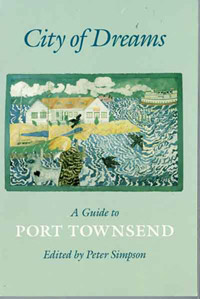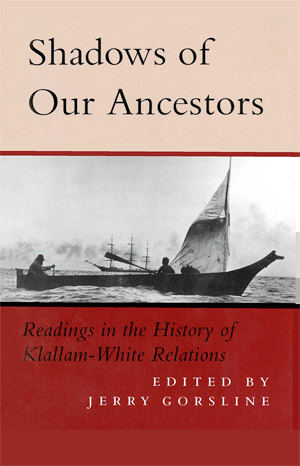 JCHS has a robust publishing program.
JCHS has a robust publishing program.
We are currently working on a rerelease of the City of Dreams, A Guide to Port Townsend, was first published in 1986. The historical society is updating and re-publishing this encyclopedic volume of the quirky history of Port Townsend and environs. To view the current working draft click HERE.
The historical society has re-published Shadows of Our Ancestors and produced catalogs to accompany exhibits:
Anne Hirondelle: Not Done Yet
Drew Elicker: Touching Color
Jim Alden: Town Painter
Palouse to the Peninsula: Five Northwest Artists Celebrate Painting
Pat and Peter Simpson: Collectors and Patrons
The Printed Word in Port Townsend: Literary Presses of the 11970s and 1960s
Current exhibit catalogues are available for purchase in the Museum Shop. All publications are available at Amazon.com.
 The Jefferson County Historical Society has reprinted Jerry Gorsline’s book, Shadows of Our Ancestors: Readings in the History of Klallam-White Relations. The book, originally published in 1992 by Empty Bowl, is a unique and valuable resource for Northwest history that has long been out of print.
The Jefferson County Historical Society has reprinted Jerry Gorsline’s book, Shadows of Our Ancestors: Readings in the History of Klallam-White Relations. The book, originally published in 1992 by Empty Bowl, is a unique and valuable resource for Northwest history that has long been out of print.
Gorsline assembled primary and secondary sources with essays and commentaries written specifically for Shadows of Our Ancestors. He presents a variety of different view points, both white and native, of events that occurred at the beginnings of European-Native contact. Gorsline’s intention is to enable the reader to draw their own conclusions from the material presented.
“It lays out, side by side, sources from different points of view and I think that’s fascinating. It lets you determine for yourself what you think might have happened there. Sometimes they complement each other and sometimes they contradict,” said Bainbridge High School English teacher, author and historian, Karen Polinsky.
“Using original source material from Indian agents, historians, and our own Tribal citizens, it offers a variety of perspectives on a transitional period in our history. Two worlds and values collided when settlers arrived in our territory,” said W. Ron Allen, Jamestown S’Klallam Tribal Chair.
Gorsline started researching S’Klallam-white relations as an effort to understand the issues raised by the 1974 Boldt Decision which affirmed Native American Treaty fishing rights and led to violent clashes between tribal and non-tribal fishermen. Gorsline’s original intention wasn’t to write a book. “It just evolved organically from my own process of discovery,” said Gorsline. As he proceeded with his research for his own understanding he thought, “this material is fascinating. It should be out there.”
When the book was published in 1992 it was well received by the general public and the S’Klallam tribes. “We use Shadows of Our Ancestors as a reference and as an introduction for those who want to know more about what our people endured. We are delighted that it is back in print!” said Allen.
When Polinski was given a copy of Shadows of Our Ancestors she was inspired to start her own research on S’Klallam history. Years later her novel Dungeness, based on the writings of historian Mary Ann Lambert, would be the result of her studies. “That was the book that introduced me to Mary Ann Lambert. Her work is unique in that it captures in writing a viewpoint that was entirely neglected. It was a Native American viewpoint with the focus on women and children as well. Without it the historical record is incomplete,” said Polinski.
Although a valued reference book, Shadows of Our Ancestors eventually went out of print. Copies could occasionally be found on-line but they were very expensive. Gorsline had tried unsuccessfully to interest various publishers in reprinting the book. “I’d finally given up when the Historical Society contacted me about maybe doing a reprint and was delighted,” said Gorsline.
Marsha Moratti, JCHS Archivist, took on the job of reprinting the book, something the Historical Society hadn’t done before. The greatest challenge of reprinting this book was that there were no computer files to work with as it was written in the 80s before personal computers could do such things. “She had to scan the entire book, losing all the formatting in the process, then re-format it following Tree’s [Swenson] design and then specify everything from the cover stock to the paper, the color of the paper, the type faces, and everything. It was incredible. She pulled it off. She did a commendable job,” said Gorsline.